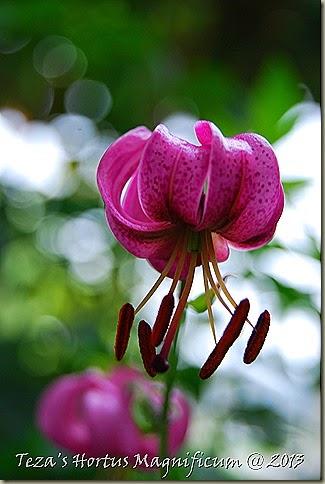Certain plants, simply put, have names that match, or in some instances rival their beauty. Such is the case with one of my personal favourites here at Teza's Garden: Glaucidium palmatum. Say the name again. Glaucidium.
Originally described by Siebold and Zuccarini in 1845, this sublime Japanese woodland plant shares the same echelon as Meconopsis, [that most beguiling blue Himalayan poppy] insomuch as it is considered by many hoarders/collectors to be a Holy Grail selection: extremely rare to locate, and as such, when it is finally tracked down, it comes with a hefty price tag. I've said it once, and I will say it again: For the hoarder/collector, price is simply a number, akin to age and weight!
It is one of the earliest plants to break dormancy in my Z5 garden, and as such is always at risk of frost damage - thus, it has its own glass cloche! Deeply veined, coarsely textured palmate leaves up to 15cm in diameter, are present along its somewhat stocky o.6m stems, becoming noticeably less lobed as they ascend. At the top of the last leaf is its silken, lavender flower, with its central boss of golden stamens. Many visitors have confused it with the genus Papaver, and indeed it does resemble a poppy somewhat. If I am not mistaken, it currently resides in the family Ranunculaceae, although I much preferred when it was considered a closer relation to Paeoniaceae!
Naturally endemic to the mountainous regions of Honshu, Japan, it prefers a cooler climate with adequate moisture retentive, humus enriched soil. Said to be hardy between Z4-8, it has been my observation that it does not suffer heat or humidity at all well. I first grew my first plant along the preternaturally shaded border that lies between mine and the neighbouring house. It was protected from the harsh midday sun as well as the somewhat damaging winds. It resided here for two years before, much like the story of its sibling Anemonopsis macrophylla, I decided it needed to be somewhere where it could be appreciated front and centre, especially during its few weeks of blooming. The northwest side of my garage offered it the same protection, as well as affording it warmer Springtime soil. The results over the past seven years have been nothing less than stunning! The photo directly above, and the final one in this post highlight the sheer beauty and magnificence of its foliage. Do not get me wrong - I adore its satiny flowers, but like many early Spring bloomers, they can be ephemeral at best, whereas the foliage remains lustrous all season long. It does produce ample seed [better so when more than one clone are grown in close proximity] which can take two years to germinate. If you want to bulk up your population, you can also divide the plant in late winter, where you will find ample dormant buds along its somewhat woody rootstock.
There is also a white flowering selection, 'Album' that may be encountered in hort retail, and while I have stumbled across it at Lost Horizons, my nearby woodland plant specialist nursery, I am not nearly as enamoured of it as I am with this beguiling gem. This final photo is one of my personal favourites from the 2014 gardening season. If you are looking for a few new Holy Grail additions for your own woodland garden, try and seek out this amazing beauty.








































1 comment:
This is a beauty from foliage to flower .. I too do not think I would be as attracted if it were a white flowered one .. you have me beginning to become more of a blue addict you naughty plant geek ! haha
Joy : )
Post a Comment